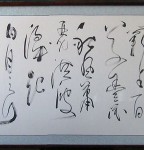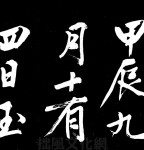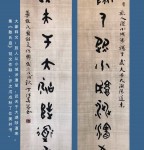Latest News of Chinese Calligraphy
Chu Suiliang 褚遂良, one of the Four Great Calligraphers of Early Tang Dynasty
- 07 April 2011
- administrator
- Hits: 40809
- Section: FAQS -
- Masterpieces
Last Updated on Wednesday, 13 April 2011 15:27
文徵明行书《明妃曲》
- 07 January 2011
- 文徵明
- Hits: 40217
- Section: FAQS -
- Masterpieces
文徵明(1470-1559),原名壁,字征明。四十二岁起以字行,更字征仲。因先世衡山人,故号衡山居士,世称“文衡山”,明代画家、书法家、文学家。汉族,长州(今江苏苏州)人。生于明宪宗成化六年,卒于明世宗嘉靖三十八年,年九十岁,曾官翰林待诏。诗宗白居易、苏轼,文受业于吴宽,学书于李应祯,学画于沈周。在诗文上,与祝允明、唐寅、徐真卿并称“吴中四才子”。在画史上与沈周、唐寅、仇英合称“吴门四家”。
文徵明于书法则是博飞专精的典范。文徵明的小楷造诣最高。主要师法传为王羲之的《黄庭经》、《乐毅论》以及钟繇《宣示》,王献之《十三行》等,又能融入唐人小楷笔法于一炉,形成“温纯精绝”的自家风貌。
文徵明的行书大致可分两大类风格:一是以王羲之《圣教序》笔意为主所写的行书小品;一是以黄山谷笔意书写的大行楷。
Last Updated on Tuesday, 29 March 2011 17:55
Philosophy About Chinese Calligraphy
- 20 December 2010
- 刘文嘉
- Hits: 31355
- Section: FAQS -
- Masterpieces
P1: Perception of Art
One day I was talking to an art student and she told me, “art is all about perception.” That’s very true and direct. Art is communion of one soul to another, offered through a symbolic language of form and content.
According to the perennial philosophy (http://www.religiousworlds.com/text/prenphil.html), the human beings possess at least three modes of knowing:
- The eye of flesh
- The eye of mind
- The eye of contemplation
The eye of flesh discloses the material, concrete, and sensual world; the eye of mind discloses the symbolic, conceptual, and linguistic world; and the eye of contemplation discloses the spiritual, transcendental, and transpersonal world. These are not three different worlds, but three different aspects of our one world disclosed by different modes of perception.
Last Updated on Thursday, 31 March 2011 13:33
Laozi (Lao-tzu, fl. 6th C. BCE)
- 10 August 2010
- 方尔加
- Hits: 40180
- Section: FAQS -
- Masterpieces
Laozi is the name of a legendary Daoist philosopher, the alternate title of the early Chinese text better known in the West as the Daodejing, and the moniker of a deity in the pantheon of organized “religious Daoism” that arose during the later Han dynasty (25-220 CE). Laozi is the pinyin Romanization for the Chinese characters which mean “Old Master.” Laozi is also known as Lao Tan (“Old Tan”) in early Chinese sources (see Romanization systems for Chinese terms).
Last Updated on Saturday, 30 April 2011 01:13
The Dragon's Embrace - China's Soft Power Is a Threat to the West
- 08 August 2010
- 天人书法网
- Hits: 38103
- Section: FAQS -
- Masterpieces
Former Chinese Foreign Minister Qian Qichen once told me, half with amusement and half with resignation, that military people around the world are all more or less the same. "They can only be happy when they have the most up-to-date toys," he said.
Last Updated on Tuesday, 10 August 2010 22:50
Aesthetics & Philosophy About Chinese Calligraphy
- 04 June 2010
- 朱良志
- Hits: 33349
- Section: FAQS -
- Masterpieces
There's no single set of criteria for calligraphy - in particular, clearly the hiragana of Heian times is working on a very different basis from the Zen calligraphy of later centuries. Nonetheless, there is some commonality. Such considerations as balance, linework and composition always apply, in some way or other. Calligraphy should be done without hesitation, with speed and confidence, but never easily - one book claims "It is said of one master that he would never accept the work of any pupil who did not get drenched with sweat through the spiritual exertion of writing."
Last Updated on Thursday, 31 March 2011 13:33













